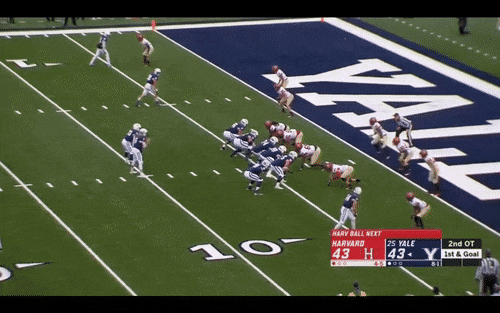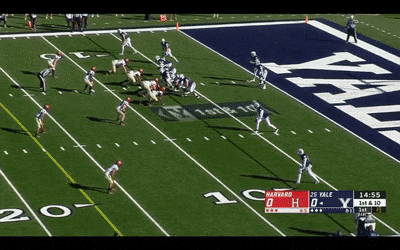Ivy Week: Yale Is Just Mini-Clemson
Yale is proving that Dabo's vertical spread can be replicated without elite receiver talent.
There’s a lot that can be learned from football programs that have to work around severe talent restrictions. It’s been true for decades. More often that not, football innovation starts at the bottom, usually in high school, and then slowly moves up into the lower levels of college. Then, an FCS coach gets hired at a major school and suddenly, everyone is doing it.
It happened with the spread option, with RPOs, with just about every major change to the sport. Installing a new scheme or system requires brings with it a lot of risk and at lower level jobs, the risk is never going to be as significant, giving coaches more room to try new things. On top of that, at the lower levels of football, talent is naturally lower and working around that requires coaches to get creative.
In other words, there’s a good reason that a lot of college football’s most innovative minds came from tiny schools like New Hampshire, Fordham or, in the old days, Miami (OH).
That’s also why looking at schools that have less to work with can often serve as a way to see the future of the sport. If an FCS program is having success doing something strange, it usually means that Alabama and Ohio State are going to be running it in five years, because if a system can work with a little talent, it can usually work even better with a lot of it.
One of the best places to look for new things in recent years has been the Ivy League, partially because of the baked in disadvantage that its schools have in recruiting and partially because of the sweet deal that the league has with television networks to get a Friday night game on TV once a week. It was almost impossible to find Ivy League games prior to just a few years ago, but now that a decent amount of the product is readily available, it serves as one of the best learning resources in the sport.
Because this is a newsletter than loves and supports all levels of college football, I figured that we could afford a week off from the glitz and the glamour of major college football and take a trip to the Ivy League. Welcome to Ivy Week.
Clemson’s offense under Dabo Swinney is one of the most defined entities in college football as it stands in 2020. The Tigers have operated a unique version of the spread offense for years. Unlike the majority of spread offenses, Clemson’s isn’t really based in air raid, attacking with quick passes underneath, nor is it a product of the spread option that Urban Meyer and Chip Kelly popularized.
Rather, Swinney’s version has a distinctly NFL feeling to it. It has pieces and parts from both the Mike Leach and Meyer offenses, but it’s a lot more of a vertical spread than it is anything else. The Tigers rely heavily on big bodied receivers and quarterbacks that can push the ball down the field, along with running backs that serve as a receiving threat out of the backfield. It’s not dissimilar from what Andy Reid is doing with Patrick Mahomes, though Clemson’s is a bit more focused on talent acquisition (understandable, because Clemson can recruit and Kansas City can’t).
The talent in Clemson’s offense is what most defines it and why it has had so much success in recent years. The Tigers have pumped out top receiver after top receiver since Swinney took over and the vast majority of those wideouts stood 6-foot-3 or taller and made their plays down the field with physicality.
It works really well because it’s hard to account for three or four massive, athletic wide receivers, but for a long time, it’s been considered less than accessible, to be generous. Unlike a lot of the variations of the spread, Clemson’s vertical base requires the kind of talent that you really can’t get unless you’re at a school like Clemson. Five-star wideouts and quarterbacks aren’t going to G5 or FCS schools.
The success that Yale has had since hiring offensive coordinator Kevin Cahill challenges that thinking. Cahill doesn’t have any direct ties to Swinney (as far as I can tell, at least), but his version of the spread is nearly a carbon copy of Clemson’s. He loves four verticals, looks to spread the defense out with throws to big bodied wideouts down the field and uses the running game mostly as a complement to the passing game rather than the more traditional inverse.

Even the running game is pretty similar to what Clemson is doing. Yale is a zone running team at its base but does a lot of its best work on read option and counter plays. This is a more traditional inside zone, but when the playbook opens up a bit, it starts to look a lot like what Clemson is doing with Travis Etienne and Trevor Lawrence.

You see that sort of counter look here, with a tight end leading the way rather than a pulling guard to avoid tipping off the linebackers about the direction of the run. Clemson didn’t have a decent tight end in 2019 so it went away from this a little but, but when guys like Jordan Leggett were around, the Tigers loved this sort of tight end lead counter, even though this is actually an inside zone split with an outside option for the halfback rather than a true counter (the blocking is basically the same, though, so we’ll count it.)

The important part of the offense is the passing game, where Yale employs basically the exact same concepts as Clemson, looking to attack the exact same parts of the defense. There’s a lot of four verts, like you see here, with a go route on the perimeter and then at least one (usually two) deep posts to cut inside of the safety. It’s designed to attack cover 2, cover 3 or man, but when it’s done well it can work about just about anything. Yale also likes to use preplay motion to get a feeling for defensive alignment, helping the quarterback to make a read before snapping the ball for where his eyes should be going first.
He reads man here and hits the receiver running his post towards the weak side of the field, away from help at safety and underneath at linebacker.

Here he reads cover 3 off of the motion and knows to hit the comeback in the soft spot underneath the deep thirds but behind the four-man shell underneath. There’s a slot post and two go routes in case of man (go route) or cover 4 (slot post) but the decision is pretty much made before the ball is ever snapped. That’s a big part of what makes Clemson’s offense so good is that thinks are made easier and simpler for the quarterback before he has to snap the ball.

Against man coverage on these four verts looks, Yale has the receivers to go up and win physical battles down the field, which is what really makes this offense tick. Having a wideout that can make plays like this is crucial and Yale has three or four of them, which is really whats makes the Bulldogs so intriguing and worth talking about. The scheme itself is interesting and solid, but if I wanted to talk about a vertical spread, I would just watch Clemson, which does it better than anybody. What’s so interesting about Yale is the fact that as an Ivy League program with such defined recruiting limitation, those receivers are still available.
Yale’s top receivers are 6-foot-1 (JP Shohfi), 6-foot-3 (Reed Klubnik) 6-foot (Mason Tiption) and 6-foot-4 (Jaylan Sandifer). Junior Darrion Carrington (6-foot-3), senior Garrett White (6-foot-2) and junior Jack Biestek (6-foot-3) all check in as well above average in height as well. That’s abnormal for a smaller school and it’s a huge part of why Yale is able to do this. Going out and finding big-bodied receivers that may not fit the athletic requirements for a place like Clemson, but do showcase good hands and an ability to win a battle in the air, seems to be a tenable way to build a program regardless of prestige, if Yale is to be considered a template. Those guys are out there, schools just have to get past some physical limitations that the big boys don’t have to deal with.
Put simply, Yale has basically built an offense around big receivers that aren’t particularly fast, but don’t really need to be. This isn’t a system built around blowing past cornerbacks and for some reason it seems like Yale is one of the few programs that understands that. Clemson recruits the best and fastest athletes because it can, not because it needs to.
That means that theoretically speaking, you could do this just about anywhere. A MAC school with Ohio, Pennsylvania and Michigan as a recruiting base should be able to find ultra-productive big-bodied receivers that may either be passed up by the bigger schools or turned into tight ends. It’s counter to the traditional thinking that underlooked receivers are usually smaller, but there’s absolutely something to be said for going after size and hands above everything else. If Yale has been finding success doing it at the FCS level, there’s really no reason to think that Clemson’s offense couldn’t be replicated at the G5 levels. That bodes well for someone like Jeff Scott.



